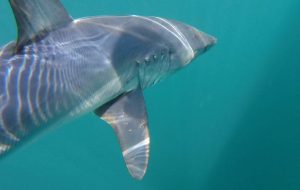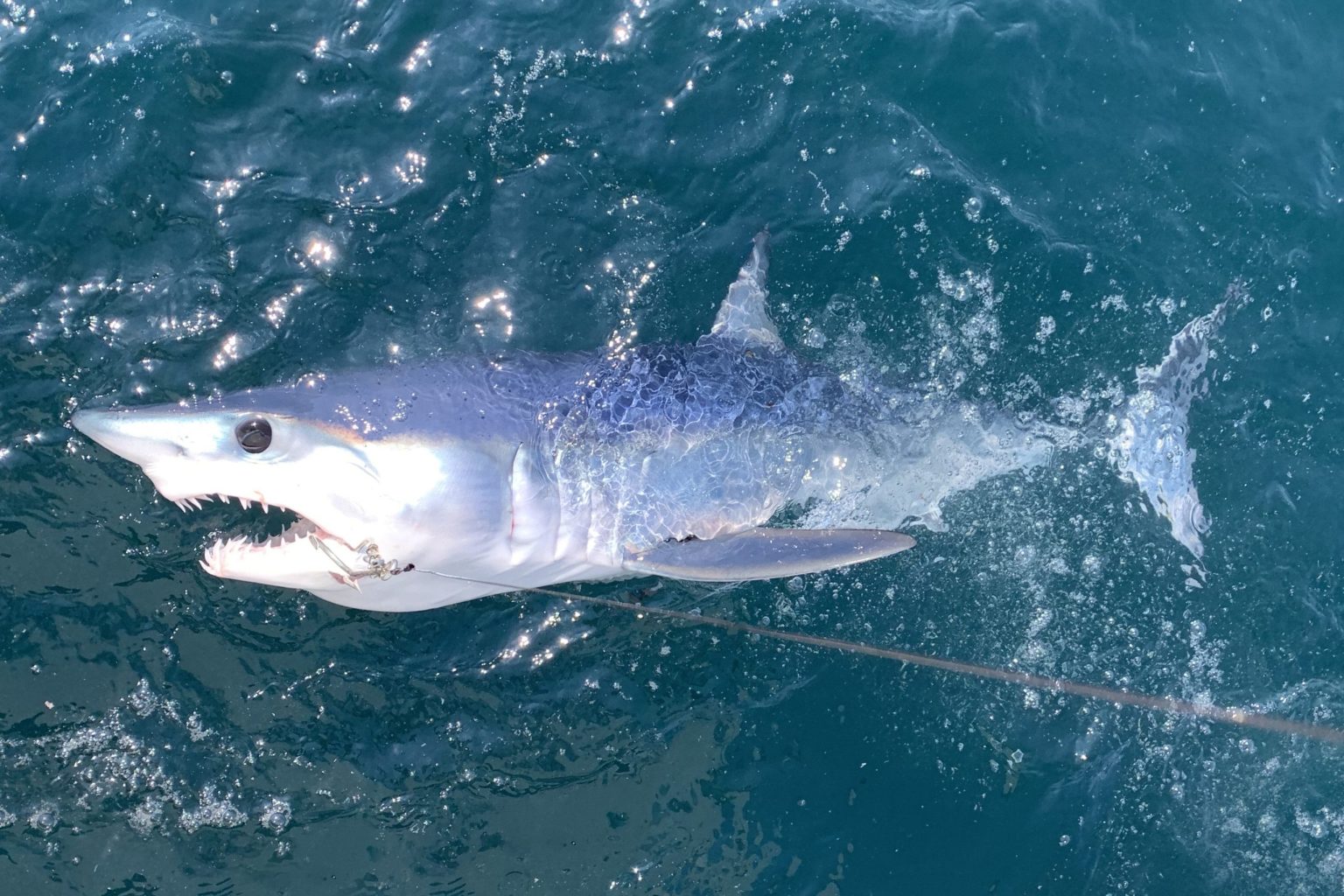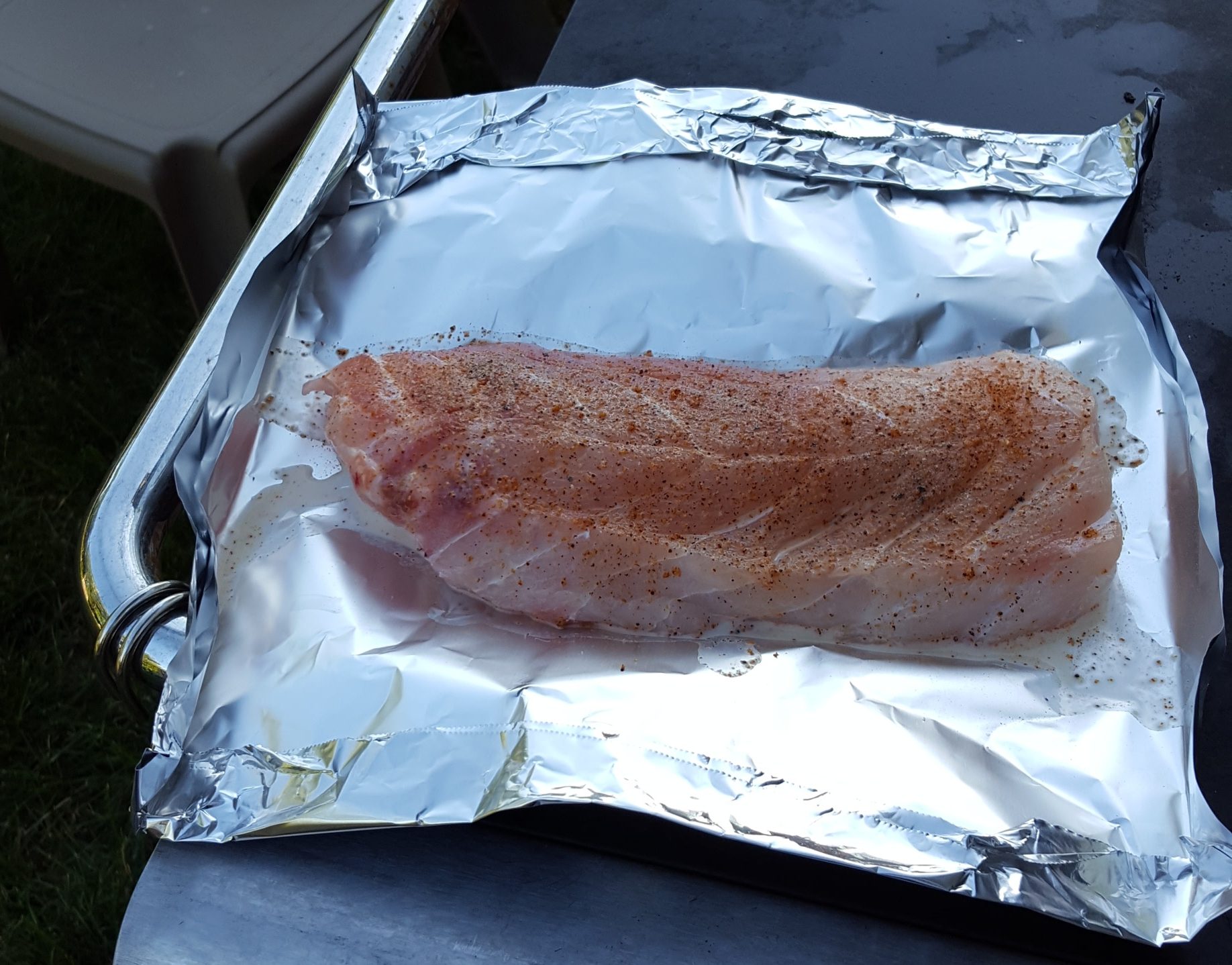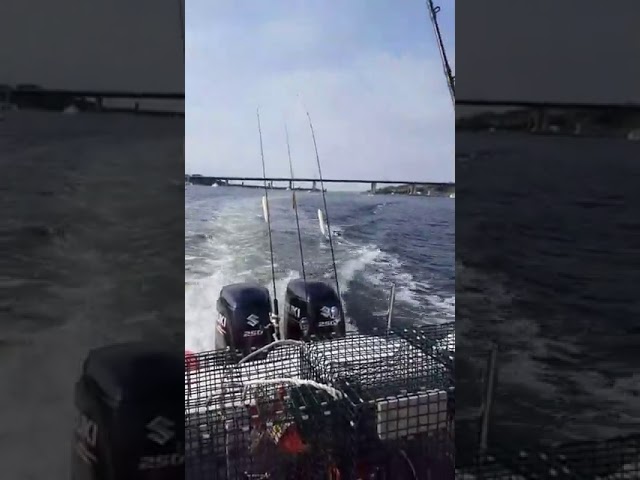Shark Fishing on Spinning Gear
Shark fishing in New England is extremely popular for fishermen looking to get their big game fix. From June-September the waters off New England welcome several species of sharks, giving anglers great opportunities for serious sportfishing. The most common sharks you’ll see are shortfin mako, thresher, porbeagle, blue and dusky sharks. Another appeal to targeting sharks is that you don’t have to go too far to find them. Sharks can be caught in abundance anywhere from 10-50 miles offshore. As technology continues to evolve, a light tackle approach to landing these fish is becoming more and more popular. At my fishing charter outfit, Tall Tailz Charters, we only use spinning gear on our shark trips. In this article, I’ll go over some shark fishing basics and a few reasons why shark fishing on spinning gear is our preferred method.
Where do you catch sharks?
If you do a little research and prepare your trip properly shark fishing can actually be very easy. On our shark fishing charters it’s not uncommon to hook up with over a dozen sharks in a day. The first step is putting yourself in an area where the odds of attracting sharks are high. The key to this is finding the right sea temperature break. Mako’s and thresher love the edge of a cold water break. Porbeagles are generally down a little deeper cruising along an even colder thermocline. Temps anywhere from 66-72 degrees is ideal. If you can find a cold water break around 68 degrees, in between the warm gulf stream eddies and the warmer inshore waters, you’ll have great odds of finding the sharks. If you keep a close eye on your offshore sea surface charts, you’ll be able to pinpoint that cold water break by late May and follow it throughout the summer as it moves east, off the New England coast.
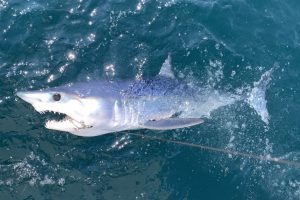
How do you catch sharks?
The recipe for catching sharks is quite simple. Find the right water then attract them to your boat. We do this by creating a long chum slick loaded with fish oil and blood emitting a very strong scent. It’s very important that your boat has a steady drift, either tide or windblown. This way your chum slick is spread over a long distance and can attract sharks from a ways away. Every shark fisherman has a different opinion on which chum mixture works best. The oilier and the bloodier, the better. For our chum, we use 2 parts menhaden to 1 part mackerel, ground up like hamburger meat. We’ll add a little water and about a quart of menhaden oil per bucket. We also like to add some
visual attractants as well, such as fine sand to make a cloud appearance and glitter or fish scales to give a nice shimmer to the slick. The buckets we use are 4-gallon square buckets, as you can fit more in your freezer than the standard round 5-gallon size. For a shark charter, we’ll bring 4-6 of these buckets for a 10-12 hour day of sharking. I drill a bunch of 3⁄8 inch holes in the bottom of 2 buckets and I simply fill the pre-drilled buckets with fresh chum after each one runs out. To start the slick I’ll tie one bucket to the stern and one to the bow. Throughout the day I’ll swap out an old bucket for a new one every 1.5-2 hours. For dead bait, we like to use bluefish, false albacore, and bonito. We butterfly the baits and remove the spine or use an entire strip. Live baits like menhaden, mackerel, and whiting also work great. I set 3 baits, one deep at 60 ft, another at 30, and the last at 15 ft. Each bait is suspended by a balloon to limit the amount of scope on the line and to double as a bobber. The fourth rod we have is our “pitch rod” with a bait rigged and waiting in the cooler for a shark that swims up to the boat. Easily half of our hookups come on the pitch rod.
What tackle should I use for shark fishing?
Every captain has a different take on the right shark rig. I’ll go over what setup works best for us and why. The mainline connection should be a 500 lb heavy duty snap swivel to a 500 lb barrel swivel crimped to 300 lb mono shock leader. Your shock leader should be 10-15’ long crimped with a piece of chafing tube on the end. Attached to your shock leader is 3 feet of single-strand wire with a haywire twist on each side connecting the shock leader on one end and your hook on the other. The size wire we prefer is the #10 weight single strand. The hook we like to use is a 12/0 VMC wide gap tournament circle. Make sure the hook you use is NOT stainless. Unless tournament fishing or harvesting to eat, you won’t be boating the shark and should cut your wire, leaving the hook in the shark’s mouth to eventually corrode and fall out. The reason I like a wire leader at 3 feet is that if the shark tries to spin while boat side and wrap itself, the wire isn’t long enough to completely wrap the fish and risk getting a bend and breaking. Additionally, when releasing the shark you can cut the hook as far down the leader as possible and still have enough wire to re-tie a hook as many as 2 or 3 more times.
What gear should I use for shark fishing?
Here is where things get interesting. For years anglers have been using heavy conventional gear from 50 to as high as 130 lb class to wrestle these powerful fish. Some fishermen fight sharks on bent butt rods right out of the gunwale. Where’s the fun
in that? If you’re not standing up to fight a 200+ lb shark you’re doing it wrong. In my opinion, the most fun, sport-oriented style to catch sharks is absolutely on spinning gear. The combo that I use on our shark charters is Shimano twin power 14k class reels paired with jigging world ghost hunter 5’ 450G MH jigging rods. Crafty one Customs in Portsmouth, RI does an amazing job pairing big game spinning setups for both sharks and tuna. I run these reels with a 65 lb Cortland Line master braid with no top shot. You can add a top shot if you’d like. I choose not to do it because it limits the amount of crucial line capacity on the spool. Shimano, Diawa, Okuma, and Quantum all offer big game spinning reels that can easily handle sharks. Once hooked up you can put the rod butt on a gimbal fighting belt or a “CUSH IT” foam butt mount that helps take the load off the butt. The advantages of using spinning gear are vast. They’re fun, plain, and simple. You can feel the power of the fish and what it’s doing at the end of your line so much clearer. They’re much lighter and easier to move around the boat if needed. They’re generally less expensive than the larger conventional gear. When mako’s and thresher take flight on their signature acrobatic jumps out of the water, it’s much easier to pick up the slack in the line and stay tight. The last key advantage is one that surprised me, being able to cast. Last year we experimented with casting artificial lures with surprising results. Using a soft artificial that can be replaced after each hookup, like a 10” Ron-Z, the smaller mako’s would go crazy chasing after it. We went 2 for 4 on one trip while waiting for larger sharks to take our deep baits.
Summary
New England shark fishing is extremely popular and for good reason. Shark fishing is one of my absolute favorite types of fishing that we do. Good sharking grounds can be as close as an hour offshore. The action is usually lights out, all day. Find the right cold water break and set up your chum slick accordingly, covering as much ground as possible. Keep replacing chum buckets every 1-2 hours so you maintain a healthy scent in the water. Make sure your rigs are clean, properly crimped, and tied. Bring plenty of fresh baits with you. Try fishing for these beasts on spinning gear. Once you try it, you won’t go back to the heavy gear ever again. To me, shark fishing is now synonymous with spinning gear! Get out there and see for yourself!
Here are a few photos from Tall Tailz Fishing Charters on their shark catches from spinning gear.
